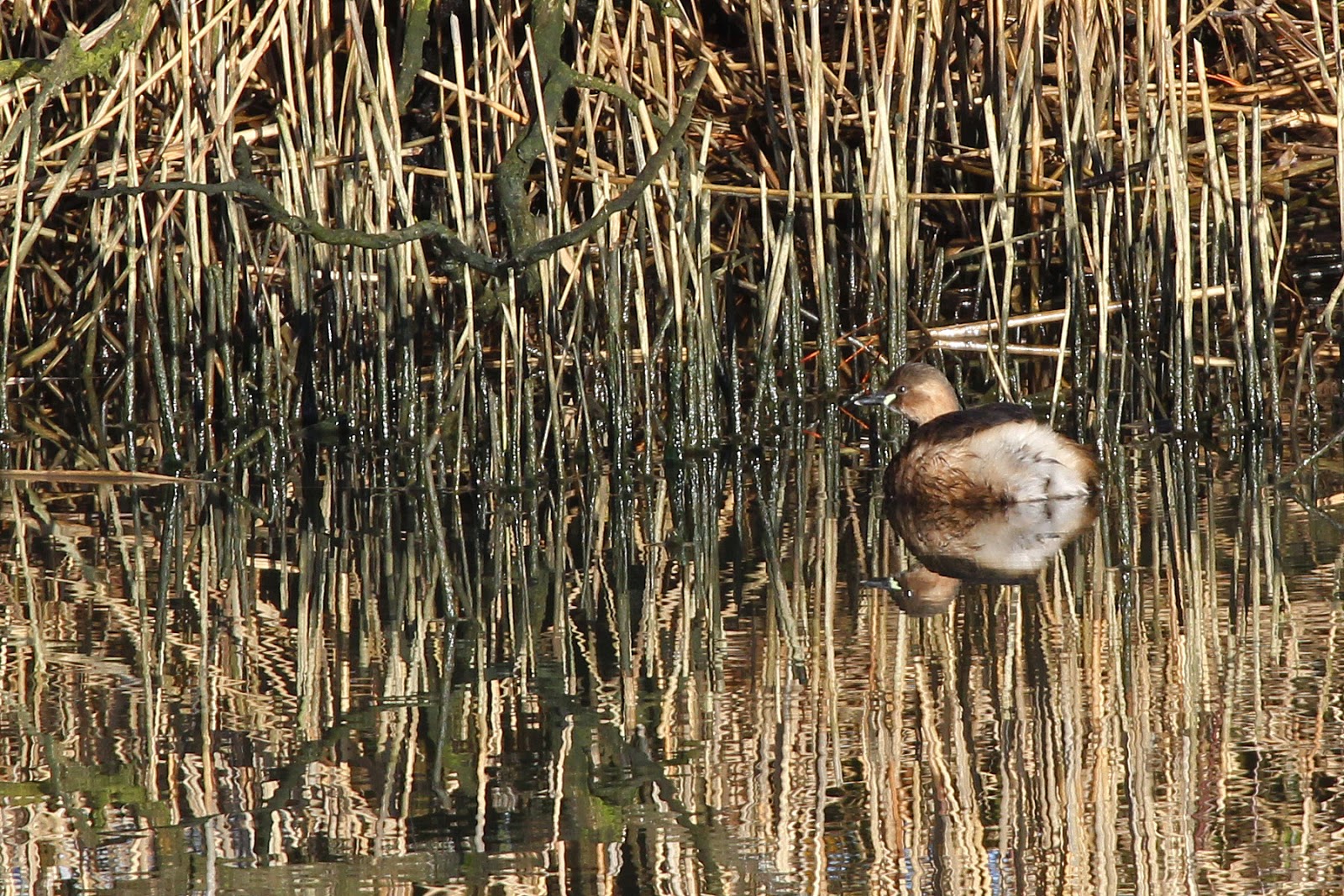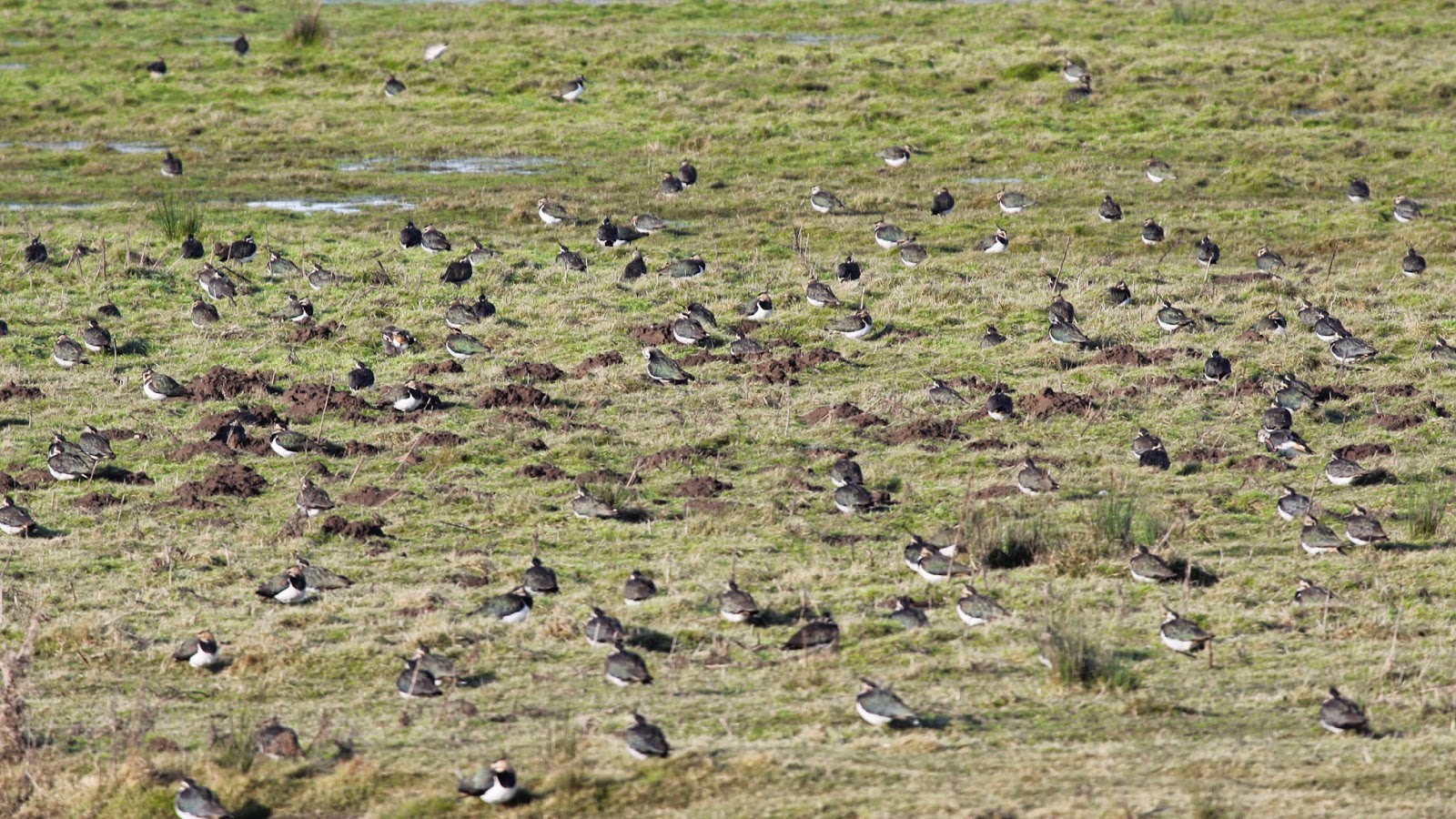After a wonderful breakfast we were off again, this time heading out through Sidlesham Quay. As we put on our boots in the car park the Blue Tits were twittering in the bushes, a sign that things were a little warmer today.
There is a thatched cottage as you come around by the quay, and it has a pond from the side of the road it was possible to see the reeds, and the sun was lighting them producing reflections in the water. A Little Grebe rested close to the water in the sunshine, what a bird to have on your garden list.
We took the path towards Sidlesham Ferry, it was quiet, a few Dunnock called but other than that there was very little about. The tide was far out, and as we approached the turn off we flushed a Little Egret and Redshank from one of the rifes.
At the visitor centre, the feeders were full and busy, its Garden Birdwatch weekend. A Carrion Crow perched high in a nearby tree watched for any opportunity. I find all the crows lovely birds, they are much overlooked but I find they have a very attractive quality.
We made our way to the Ferry pool, and scanned out over the water. The main feature was the vast number of Lapwing, they seemed to be everywhere. This panorama doesn't do the numbers justice, but it does show what a lovely morning it was.
This picture shows the density, imagine this times ten, and you would be able to understand how many Lapwing there were, easily over a thousand.
There were a pair of Tufted Duck on the open water, and a few Shelduck, and Shoveler, this was the only one on the water though, the others were tucked into the bank of the pool fast asleep..
We took the footpath from the pool out across the fields, Pipits flew up from the flooded long grass, and there was always the possibility there could have been Water pipits but they were distant and difficult to pin down as they hid amongst the tussocks.
The walk was difficult with the path being muddy and wet, this increased in difficulty in those areas protected from the sun and wind. Alarm calls rang out and a Kestrel flew low over the field and settled in a distant bush.
It didn't stay long and was quickly off low along one of the rifes. Black-headed Gulls quartered the fields like owl, scanning the soil for any opportunity of food. Distant birds would raise hopes of maybe an owl.
We walked to the footbridge by the Medmerry ridge, and walked up to look over the new flooded area. The tide was out and there were a few pools and streams, the open mud though was dominated with Ringed plover, I counted at least 100 birds scattered, and feeding on the mud.
We walked towards the Chainbridge field, where a flock of about 500 Brent Geese were feeding on the grass. As we watched them a female merlin zipped past low along the ridge and then quickly out of sight, another missed opportunity with this elusive little falcon.
As we entered the holiday park we flushed a Green Woodpecker from the playing area, and it sat obligingly on the fence.
We made our way through the mobile homes to the beach. Scanning the sea I found a group of very distant Common Scoter, a Greta-crested Grebe and this very distant Red-throated Diver heading east.
We walked along the beach path towards the Bill. It was still quite cold, but a lovely day in the sunshine, the visibility was very good and behind the perched Cormorant was the Isle of Wight cliffs shining out in the sunshine.
We followed the path around the Bill, and then to the Lifeboat Pub where we stopped for lunch. We sat outside in the shelter and warm sunshine. Across the road a pair of Herring Gulls were putting on two completely different displays. This one was calling out in that aggressive way that probably does not endear them to many, but can show off the power this bird has.
While the other was content to just sit and hunker down and enjoy the warmth of the mid day sunshine.
We set off along the sea wall past the Lifeboat station. On a sunny winter's day the sea wall gets very busy with walkers, both on their own and with their dogs. The tide was coming well in and the groynes were disappearing fast. On the pebble beach Turnstone could be seen looking for any possible opportunity for food, and they would also move up to the groyne where they would sit.
Every so often the sea would come in a little too high and the birds would fly off. They seem to have a sixth sense that tells them when a particular high wave will hit, and fly off before it does.
Then they just return, their orange legs somewhat enhanced by the sunshine.
A few Black-headed Gulls were on the sea, but a gull sitting on a distant buoy did not look quite right, and sure enough closer inspection revealed it to be Sandwich Tern.
It is only just recently that these birds have been seen to over winter along the coasts, previously they would be one of the heralds of spring as they turned up in mid March. This one has a ring on its right leg, but is too far away to be able to get any detail.
Several Gulls flew up the beach, but these were also not the commoner Black-headed. The totally white wings and bright red beak identifying them as Mediterranean Gulls. From below the white primaries look beautiful against the deep blue of the sky.
We made our way to the harbour where the tide was really high creating a huge lake with only a few islands on which many Oystercatchers were gathered. I had hoped that there would be a collection of waders roosting on the iron structure, but this was almost completely submerged, and all I could find were these few Grey Plover.
Close by to the plover were a pair of Goldeneye. The male looking splendid in the sunshine. The light picking out the bottle green colour in the head, and the yellow eye revealing why they are called what they are.
The male did a little bit of displaying, pointing its head skywards and raising itself out of the water and flapping its wings.
As I tried to get closer I disturbed a small flock of Skylark, they settled back onto the beach and slowly started pecking at the seed heads of the vegetation and in between the pebbles.
We turned to make our way around the path to Church Norton only to find that the tide had completely covered the path making it not passable. The alternative was to turn back and walk through Greensleaves farm, adding some more miles to a walk that was now becoming a good trek. To prepare ourselves for this we took a break and sat on the beach in the sunshine. Lovely hat!
There are always Turnstone on the beach by the edge of the water, and if you sit still they will make their way quite close to you.
The walk through the farm as usual turned up nothing, and we also made our way across country, and then along the road to the Ferry Pool. A Green Woodpecker and a Kestrel were the only birds in the fields, at the Ferry the lapwing numbers had dropped slightly, and there were less duck than in the morning.
From the visitor centre we walked alongside the stream which was very high from the tide. A pair of teal dropped in and the male once again provided the perfect scene in the winter sunshine.
Coming out into the harbour the water while high was a beautiful blue, and all over there were Black-headed Gulls dipping in. On what little land there was there were Curlew sitting out the tide waiting for the mud to return.
Wigeon and Brent would fly over, the ducks settling on the water, the geese away to the east. Another flock coming over from the ferry Pool was a group of Black-tailed Godwits, the sunlight picking them out as they made their way towards the north wall.
As we neared the quay I picked out one of my favourite ducks the Pintail, there were three two males and a female. Unfortunately this duck always manages to stay to far away from the camera for the perfect picture, one day perhaps one will.
The scene that greeted us at the quay was so impressive we just had to sit down and take it all in, the wonderful blue sky and water, and the golden glow of the buildings and distant grass.
Absolutely wonderful.
Close up the reflections of the building also made a wonderful abstract scene.
As we sat there a large flock of Brent Gees flew in to the area just behind the quay. They announced their arrival with their endless calls, and once settled on the water continuied to chat away to each other.
More and more Brent Geese continued to fly in, adding to the wonderful noise that was drifting across the harbour. In the low sunshine the dark greys of the gees seemed to turn to a golden glow.
The noise of the geese built to a crescendo, and all of a sudden the volume increased and then their calls were joined by the rush of their wings as they burst into the air. You could hear the sound of well over a thousand wings beating away as they lifted off the water and into the air, and this was then replaced by the honking as they circled around, and then headed off towards the fields on the north wall. An amazing sight and sound that just added to the magic of this final part of a wonderful day.
Thousands of Geese streaming past us.
In between all this the Black-headed Gulls continued to fly around dropping down on to the water, either delicately picking up from the water or plunging in.
Difficult to know what was going on here, but I suspect that as the tide rises it flushes out insects or seeds. The insects float on the water, and the gulls take advantage. I followed the gulls as they flew around, trying to get that perfect shot where the bird just dips into the water, and there is the reflection. Frustratingly I couldn't get the perfect one, but these were quite close.
The sun was now getting very low, and the temperature was falling too. The tide was also moving out, and more grass was becoming exposed. The gulls continued to fly around, but by now they were becoming silhouettes against the orange evening sky.
It had been a wonderful day, a long walk, and we were going to suffer, but I can put up with that when you can look back on the beautiful time we had. It was back to the bar, and another birthday drink and then off to get ready for dinner, yet another wonderful "special" in the Crab & Lobster.






































No comments:
Post a Comment